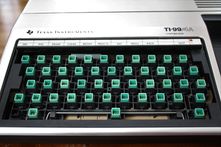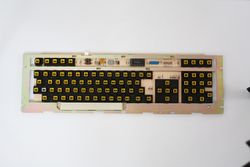Stackpole switch grid
| This article requires additional photographic illustration |
This article is a stub. You can help Deskthority by expanding it.
| Manufacturer | Stackpole |
|---|---|
| Switch type | Linear |
| Sense method | Metal leaf |
| Switch mount | PCB mount |
| Patents |
US4255635 (1979) US4342892 (1980) |
Stackpole switch grid is a provisional name for at least two types of single unit multiple switch assemblies (switch grids), the basic design of which was copied from the Hi-Tek High Profile switch grid.[1]
Contents
Description
The name refers to the fact that the switches are not discrete: all the switches are formed from a single moulded block of plastic. Holes in the bottom of this plastic array allow the switches to connect onto the PCB.[2]
The contact mechanism is formed of two leaf springs that are held apart by a horizontal bar in the slider; when the slider is depressed, the bar is lowered and the contacts close. The switches are open at the top. Confirmed slider colours are colourless, yellow and green.
Although rare, discrete switches in this series do exist: both the Lear Siegler ADM11 and Intel iPDS keyboards feature discrete switches, as well as smaller switch clusters.
Recognition
Historically there has been much confusion about differentiating Stackpole and Hi-Tek switches. However, this differentiation is now fairly certain.
Variants
Standard profile
Standard profile grids have a "waffle" frame.
Intel iPDS yellow switches
Texas Instruments TI-99/4A Green switches
Low profile
Low-profile grids have shorter slider guide shafts, and flat webbing between them. The sliders and switch contacts are both different in design to the tall switches.
Stackpole interlocking is an alternative version of this switch in the form of interlocking single-switch modules.
Lear Siegler ADM 11 switches; note the white alternate action switch within the grid
Keyboards
Confirmed
The following are referenced sources where the manufacturer name or logo has been found on the switches or PCB:
- Some Atari 800 microcomputers: Stackpole[3][4] and Hi-Tek[5]
- Intel iPDS (standard profile, yellow)
- Lear Siegler ADM11 (low-profile, yellow)
- Oric Atmos microcomputer (low-profile, white sliders)[6]
Unconfirmed
Keyboards where the design characteristics sufficiently match known Stackpole keyboards:
- CASI KB-2 S keyboard (standard profile, yellow sliders)[2]
References
- ↑ Deskthority — Hi-Tek Corp. History
- ↑ 2.0 2.1 Google+ — CASI KB-2 S Dated 2011-10-15. Retrieved 2015-08-02.
- ↑ (Wayback Machine) AtariAge Forums — 600/800XL Keyboard variants Archived 2013-01-31. Retrieved 2015-08-02.
- ↑ AtariAge Forums — Hacking the Atari 800 Keyboard & CX85 Keypad onto a USB PC Keyboard Circuit Dated 2009-12-26. Retrieved 2015-08-02.
- ↑ AtariAge Forms — 800 Restoration Dated 2012-11-24. Retrieved 2015-08-02.
- ↑ Deskthority — Hi-Tek vs Stackpole Posted 2013-12-15. Retrieved 2015-08-02.




